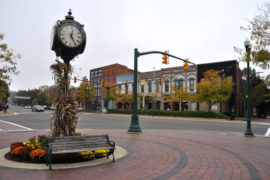When we first heard two years ago that roundabouts were coming to Dexter, the news was received with mixed reviews. The traffic circles are here and Dexter is a roundabout town.
For those of us who may have had reservations about the traffic circles, that anxiety may have stemmed from negotiating the State St/Ellsworth Rd roundabout and the Lee Rd/Whitmore Lake Rd roundabout. Both of these intersections are in Michigan’s top ten most dangerous roundabouts for 2017.
Note: “Dangerous” refers to the number of crashes without taking into consideration the severity of crashes or the injuries incurred. The State St/Ellsworth roundabout was 4th on the list with 110 crashes but only 2 injuries. The Lee Rd/Whitmore Lake roundabout was 7th with 64 crashes and only 4 injuries.

Having been through both the Lee Rd and State St roundabouts a few times, if I dared look, I’m sure my Fitbit would show a dramatic leap in heart rate as I approached either one. If the feeling is at all mass mutual, it is no wonder the idea of roundabouts in Dexter might cause a spike in anxiety.
However, as counter-intuitive as it may seem, these confusing traffic circles are actually safer as the graphic at the end of this article illustrates.
Data from traffic accidents that occurred between 1998 and 2007 showed 22% of all traffic-related deaths and 45% of all traffic-related injuries occur in intersections. On average, that is 9,000 deaths and 767,000 injuries from intersection collisions every year in the United States.
Intersections converted to roundabouts show a:
- 38% reduction in all crashes.
- 76% reduction in injuries.
- As much as 90% reduction in fatalities.
- Pedestrian/cyclist incidents reduced by 40%.
But when there is a mishap, how is fault determined in a roundabout accident?
Oakland County Sheriff’s traffic investigator Jerry Yaldo elaborates on Michigan Auto Law as to how fault is determined in a roundabout accident:
“If there are no shoulders in the roundabout, the drivers would have to drive their vehicles out of the roundabout, and to a place where they can pull off the roadway while they wait for law enforcement to arrive at the scene.
“The officer on scene will speak to both drivers to get an understanding of what happened. The officer will also speak with any independent witnesses that may have seen the crash. The officer will look at the damage on both vehicles and will then determine who is at fault.
“Most crashes in roundabouts are the result of one driver failing to yield the right of way to a vehicle already in the roundabout. When that happens, the driver that did not yield would be put at fault. The other most common crash would be a sideswipe crash, which happens when one driver changes lanes in a roundabout and strikes a vehicle that was legally in its lane.
“A crash report is an officer’s opinion of what happened. The officer may decide that both drivers were at fault or that fault cannot be determined.
“In regards to who has the right of way in a roundabouts: The person already in the roundabout would have the right of way and the person that is attempting to enter the roundabout does not. If a driver enters the roundabout and strikes a vehicle that was already in the roundabout then he would be cited for failing to yield the right of way.”
Here are a few tips to make roundabouts safer:
Slow Down: Roundabouts are designed to reduce speed upon entry. While it may seem counter-intuitive, slowing down in a roundabout alleviates congestion. Slower speeds also make roundabouts safer than traditional intersections.
Yield, Don’t Merge: Vehicles traveling in the roundabout have the right-of-way. Do not merge into a roundabout like you merge onto a highway. Slow down and yield, or sometimes stop, for traffic that is circulating the roundabout. Enter the roundabout when a safe gap is present.
Exiting a roundabout: Use your RIGHT turn signal/indicator when exiting the roundabout. As you exit, be aware of pedestrians that may be crossing the roadway.
Worth repeating: A roundabout is a “yield-at-entry” intersection. Vehicles inside and circulating within the roundabout always have the right-of-way. Motorists and bicyclists wishing to enter the roundabout must yield to circulating traffic and wait for a safe gap to enter. This may mean motorists must completely stop at the yield sign until a safe gap is present.

Roundabout infographic created by Michigan Auto Law. Visit our Roundabout Resource Center for more information.









